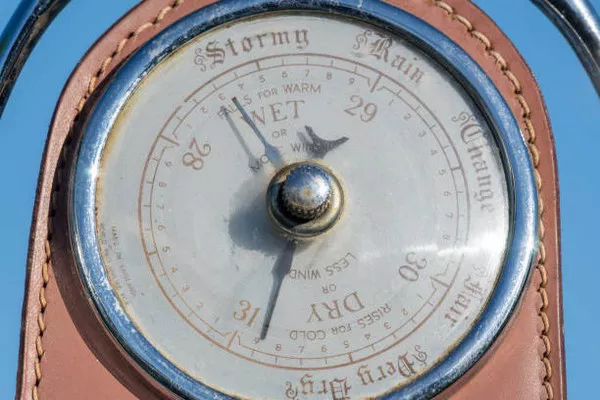Barometers are crucial instruments in meteorology, used to measure atmospheric pressure. This measurement is vital for weather forecasting, aviation, and various scientific applications. Barometers come in several types, but the three main types are the mercury barometer, the aneroid barometer, and the digital barometer. Each type has its unique mechanism, history, and application areas. In this article, we will explore these three main types of barometers in detail, discussing their working principles, advantages, and uses.
1. Mercury Barometer
History and Development
The mercury barometer, invented by Evangelista Torricelli in 1643, is the oldest type of barometer. Torricelli’s invention came from his interest in the relationship between atmospheric pressure and weather changes. By observing the behavior of mercury in a tube, he could measure atmospheric pressure with unprecedented accuracy.
Working Principle
The mercury barometer consists of a glass tube, closed at one end and filled with mercury. The open end of the tube is immersed in a reservoir of mercury. When the atmospheric pressure changes, it forces the mercury in the reservoir to move up or down the tube. The height of the mercury column, usually measured in millimeters or inches, corresponds to the atmospheric pressure. The standard atmospheric pressure at sea level is 760 millimeters of mercury (mmHg).
Advantages and Disadvantages
Advantages:
Accuracy: Mercury barometers are known for their precision. They provide very accurate measurements, which is why they have been used as a standard for calibrating other barometers.
Stability: Mercury does not evaporate at normal temperatures, ensuring the barometer’s longevity and reliability.
Disadvantages:
Toxicity: Mercury is a toxic substance, posing health and environmental risks if the barometer breaks.
Size and Portability: Mercury barometers are typically large and fragile, making them difficult to transport and unsuitable for mobile applications.
Applications
Mercury barometers are primarily used in laboratories and for educational purposes where accurate atmospheric pressure measurements are required. They are also used as reference instruments for calibrating other barometers.
2. Aneroid Barometer
History and Development
The aneroid barometer was invented in 1844 by French scientist Lucien Vidi. Unlike mercury barometers, aneroid barometers do not use liquid, making them more practical and versatile for various applications.
Working Principle
An aneroid barometer consists of a sealed, flexible metal chamber called an aneroid cell. This cell expands or contracts with changes in atmospheric pressure. The mechanical movement of the cell is transferred to a needle on a dial through a series of springs and levers. As the atmospheric pressure increases, the cell compresses, causing the needle to move in one direction. Conversely, when the pressure decreases, the cell expands, moving the needle in the opposite direction.
Advantages and Disadvantages
Advantages:
Portability: Aneroid barometers are compact and durable, making them suitable for use in various environments, including on ships, aircraft, and in the field.
Safety: Since they do not contain mercury, aneroid barometers are safer for both users and the environment.
Cost: They are generally less expensive to produce and maintain than mercury barometers.
Disadvantages:
Calibration Drift: Aneroid barometers can drift over time and require periodic calibration to maintain accuracy.
Sensitivity: They are less sensitive to small pressure changes compared to mercury barometers.
Applications
Aneroid barometers are widely used in meteorology, aviation, and marine applications. They are also common in household weather stations and portable weather instruments due to their durability and ease of use.
3. Digital Barometer
History and Development
With the advent of modern technology, digital barometers have become increasingly popular. These devices utilize electronic sensors to measure atmospheric pressure and provide digital readouts.
Working Principle
Digital barometers use various types of pressure sensors, including piezoelectric, capacitive, and strain-gauge sensors. These sensors detect changes in atmospheric pressure and convert them into electrical signals. The signals are then processed by a microcontroller, which displays the pressure readings on a digital screen. Many digital barometers also include additional features such as temperature and humidity sensors, data logging capabilities, and wireless connectivity.
Advantages and Disadvantages
Advantages:
Accuracy and Precision: Digital barometers can provide highly accurate and precise measurements, often surpassing traditional barometers in performance.
Additional Features: They can be integrated with other sensors and systems, offering a comprehensive set of environmental data.
Ease of Use: Digital displays are easy to read, and many devices offer user-friendly interfaces and connectivity options for data analysis.
Disadvantages:
Power Dependency: Digital barometers require a power source, such as batteries or an electrical outlet, which can be a limitation in remote or mobile applications.
Cost: High-end digital barometers can be expensive, particularly those with advanced features and high precision.
Applications
Digital barometers are used in a wide range of applications, from professional meteorological stations to personal weather gadgets. They are essential in industries that require precise atmospheric pressure data, such as aviation, maritime, and environmental monitoring. Digital barometers are also commonly found in smartphones and wearable devices, providing weather information to users on the go.
See Also WHY AN ANEROID BAROMETER IS PREFERRED OVER A MERCURY BAROMETER
Conclusion
Barometers, in their various forms, are indispensable tools for measuring atmospheric pressure and forecasting weather. The three main types of barometers – mercury, aneroid, and digital – each have distinct features, advantages, and disadvantages that make them suitable for different applications.
Mercury barometers, despite their accuracy, are limited by their size, fragility, and the hazardous nature of mercury. Aneroid barometers offer a safer and more portable alternative, though they may require periodic calibration. Digital barometers, leveraging modern technology, provide high accuracy and additional functionality but are dependent on power sources and can be costly.
Understanding the differences between these barometers allows users to choose the right type for their specific needs, whether for scientific research, aviation, maritime navigation, or personal use. As technology continues to advance, barometers will likely become even more accurate and versatile, further enhancing our ability to monitor and predict atmospheric changes.

